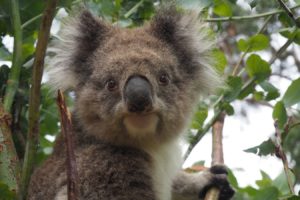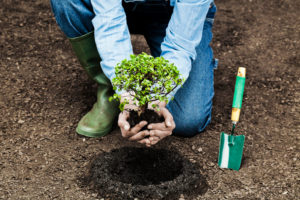Climate Change Threatening Koalas in the Bush
Brazil isn’t the only one suffering the effects of forest fires. In Australia, bushfires, which have grown increasingly more severe and have begun much earlier this year than in the past, are threatening Australia’s residents and wildlife.
In early September of this year, Australia witnessed its first and most severe series of bushfires on the eastern seaboard. Another series of fires occurred in October in northern New South Wales and Queensland, damaging at least 30 homes. According to experts, Australia is witnessing bushfires much earlier than it has in the past due to drier and hotter weather conditions as well as more extreme winds. In fact, firefighters are now telling Queensland residents that extreme bushfires should be considered the new norm.
Despite the obvious concern for resident and home safety, more extreme bushfires are concerning scientists in regard to wildlife: in particular, koala bears.
Koala Where?
For those of you who perhaps don’t take the claims of climate change too seriously but do love animals, the fate of Australia’s koala bears might concern you.
 The extreme bushfires that plagued Australia’s eastern states this September killed an estimated 350 rare koalas trapped in the bush. Cheyne Flanagan, clinical director of Port Macquarie Koala Hospital, described in an interview the horror of listening to the crying koalas, whom she treats for burn wounds. According to Cheyne, radiant heat following the blaze can be the most threatening to the species, as the heat cooks them alive.
The extreme bushfires that plagued Australia’s eastern states this September killed an estimated 350 rare koalas trapped in the bush. Cheyne Flanagan, clinical director of Port Macquarie Koala Hospital, described in an interview the horror of listening to the crying koalas, whom she treats for burn wounds. According to Cheyne, radiant heat following the blaze can be the most threatening to the species, as the heat cooks them alive.
Climate change isn’t the only cause of the more intense, earlier occurring bushfires, however. Deforestation is also a culprit, and according to Stuart Blanch, Australian Forest and Woodland Conservation Policy Manager at WWF in Sydney, the bushfires prompted by these elements will lead to the functional extinction of koalas in the next 50 years.
Habitat loss and death caused by these bushfires will lead to the loss of healthy and genetically diverse koala species, eventually leading to their extinction. According to Blanch, 3,000 hectares of land were bulldozed in the past two years in the last remaining habitat for koalas in NSW.
Climate Change Threatens Koalas
Climate change poses various threats to koala bears. First, we know that bushfires caused by reduced rainfall and increased temperatures are threatening koalas. But increased CO2 levels also pose a threat to this incredible species.
Since the Industrial Revolution, CO2 levels have increased globally from 280 ppm to 387 ppm. By 2050, this number is expected to rise to between 500 and 600 ppm. An increase in CO2 levels results in faster plant growth.
Yet, it also results in decreased protein levels and increased tannin levels in plants’ leaves. (Tannins are proteins that make plants hard to digest.) Thus, as CO2 levels rise, the leaves that koalas depend on for food will decrease in nutrition content.
 These leaves, however, already possess very low levels of nutrients. Koalas feed on eucalypt leaves, which contain poor nutrition quality and high levels of tannin. Due to this, koalas need to eat at least 500 grams of leaves per day to survive.
These leaves, however, already possess very low levels of nutrients. Koalas feed on eucalypt leaves, which contain poor nutrition quality and high levels of tannin. Due to this, koalas need to eat at least 500 grams of leaves per day to survive.
According to scientists, koalas are not expected to adapt well to climate change. Koalas have low levels of genetic variation within their populations due to a period in which the koala species almost went extinct, resulting in inbreeding.
With habitat loss and poor nutrition, koalas will likely see extinction. Koalas already face various threats, such as car accidents; dog attacks; drowning in swimming pools; and diseases.
In order to protect koala bears from extinction and to protect other species from the effects of climate change, we must act now.
Forests can Fight Climate Change (if we let them)
While many of us cannot directly help koalas, we can help the environment. Many plant and animal species are suffering the effects of forest fires, deforestation, and other effects caused by climate change. By protecting earth’s forests, however, we can save them.
Forests help the planet in two ways: storing and sequestering carbon.
Carbon storage is the amount of carbon retained in a carbon pool within a forest. As the forest ages, storage levels increase. Carbon sequestration is the process of removing carbon from the atmosphere via photosynthesis and using it for growth. Young-medium aged forests sequester carbon better than older forests.
Now, we’ve all heard the claim that planting more trees won’t help the environment because young trees can’t store carbon. To an extent, this claim is true. Newly planted trees won’t store carbon as well as older trees will, but planting new trees will help sequester carbon from the atmosphere. (So, basically, it’s the same effect. We are merely mincing words.)
We can help our forests in two ways:
- Reduce or end deforestation: It is vital to keep old forests from being cut down. When trees are cut down, that carbon is released back into the atmosphere, warming the planet. By keeping forests as they are, we can continue to store carbon while preventing any more carbon from entering the atmosphere. Instead of using wood as a commodity, we can switch to other plants, such as hemp. This will reduce deforestation.
- Plant more trees: By planting more trees, we can help reduce carbon levels in the atmosphere, and over time, these trees will store more and more carbon.
Trees aren’t the only forest-dwellers to store and sequester carbon. There are five carbon pools within a forest, including:
- Live Above-ground Pools: trees, shrubs, and other plants
- Live Below-ground Pools: roots
- Deadwood: standing dead trees and logs
- Litter: leaves, needles, and small branches
- Soil Organic Matter: organic matter, such as decayed biomass.
Gardeners’ Call to Action
So gardeners, while we can’t all hop on a plane to Australia and plant more trees for those adorable marsupials, we can help the endangered and threatened species in our own country and yards.

To start, we can plant more trees. If you can’t plant trees in your own yard, volunteer to plant trees with an environmental conservation organization. In our own yards, we can use more sustainable gardening methods, such as ditching pesticides and herbicides and switching to environmentally-friendly fertilizers, such as xVital.
This is your call to action. Will you act?
Sources:
Queensland Bushfires: Extreme Season now ‘The New Normal’
Climate Change Partly to Blame for Early Bushfire Season
Australia’s Iconic Koala Threatened by Deforestation and Bushfires
Forest Carbon: an Essential Natural Solution for Climate Change











